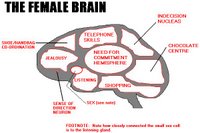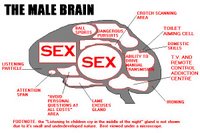How to Use Technology to Be Funny and Successful
De presentator liep met een cd aan een touwtje om zijn nek. "Ja, je ziet tegenwoordig veel mensen rondlopen met een usb stick, maar daar hebben we bij ons op school geen geld voor".
De toon was gezet en zo lardeerde Peter M. Jonas, PhD, Chair, Doctoral Leadership Studies Department van de Cardinal Stritch University bijna z'n hele verhaal met de nodige grappen tussendoor, waarvan de meeste nog leuk waren ook.
Zijn verhaal is eigenlijk heel simpel.
Wanneer het aankomt op het onthouden van wat iemand gezegd heeft geldt het volgende:
- After 10 min. 10% will be drifting off
- After 15 min. 10% more will be taking mental vacations
- After 20 min. another 25% will be dreaming of sexual fantasies
- So, I have no apologies for the pleasure I am about to give 25% of you. (I expect a standing ovation at the end.)
"Once you get people laughing, they’re listening and you can tell them almost anything."
Herbert Gardner
Vervolgens komt hij met een zeer theoretische verhandeling over de werking van de hersenen waarbij hij regelmatig verwijst naar de openingsspeech van Ramachandran.
Uiteindelijk laat hij ook een paar plaatjes zien van hersenen, maar dat zijn andere dan we van de keynote gezien hebben:

Dan noemt hij:
Videothe technology of electronically capturing, recording, processing, storing, transmitting, and reconstructing a sequence of still images representing scenes in motion.
Pedagogy
the term generally refers to strategies of instruction, or a style of instruction.
En komt doodleuk met de term: Videagogy waarbij hij stelt
Words are 7% effective
Tone of voice is 38% effective
Non-verbal clues are 55% effective
- WHAT leaders say is not nearly as important as HOW they say it!
- A dull message delivered by a charismatic leader will be more readily accepted.
- However, an excellent message delivered by someone who is not interesting, will not engage the audience.
Dan doet hij ons mogelijkheden aan de hand om humor te gebruiken:
Use your PDA or iPhone to store funny top ten lists, jokes, cartoons, pithy sayings etc. to use when they fit the content of meeting or class.
Present funny awards at meetings.
Bring in funny and motivational speakers.
Tell humorous stories to make your point and allow students and staff to tell stories or jokes.
Let students use rap songs in class. You can use rap in speeches or meetings. The funnier the better—get you material on YouTube.
Find humorous electronic books for class, e.g. Statistics for Those Who Think they Hate Statistics.
Use exaggerated speech or facial expressions.
Directing and participating in learning-related games that give risk-free practice is typically a successful teaching tool.
Have your staff read humorous books that have a message. Books like, Leadership by Attila the Hun, The Art of Being Lazy, or any book by Scott Adams, the creator of Dilbert, can be both clever and informative.
Instead of professional development have a comedy troupe come in. Wavelength from Chicago is entertaining, funny, and they have a message.
Keep a list of jokes on your computer or PDA to use when students or staff get out of hand.
Some teachers simply take humor breaks and show funny videos from YouTube. You can even have staff or students nominate the videos to use.
Give funny prizes for the worst tie, funniest comment, first to attend a meeting.
Have trivia contests: www.funtrivia.com or www.trivia.com
Do not be afraid to laugh at yourself.
Om tenslotte te eindigen met de 10 wetten van humor:
- Develop a database of jokes, stories, sayings, puns, and material.
- You do not have to reinvent the wheel—steal your information.
- Always look for connections with your material.
- Be sure to plan out the jokes--Look spontaneous and be prepared.
- Collect overheads and be sure to label them or categorize them. Share jokes and cartoons with your colleagues. Be prepared.
- Keep track of the reactions you get with various jokes, stories, and activities.
- Look at reality for some of the funniest things to discuss and use.
- Do not be afraid to encourage students and staff to develop a sense of humor--Humor can be very contagious; let it happen.
- Just do it. Don’t be afraid to make mistakes.
- Be sure that you have tenure or a second career to fall back on before you try any of the suggestions.
Je kunt je voorstellen dat dit voor mij een bijzondere start was van de conferentie, maar wel een heel leuke!
De presentatie met daarin veel leuke cartoons is hier te downloaden. (Let op: 18Mb)



Inderdaad een heel leuk onderwerp om mee te beginnen. En bedankt voor je uitgebreide verslag! Ik hoop dat je meteen volgende week al de geleerde dingen gaat toepassen bij de ambassadeursdag in Hilversum!
Die van die CD is echt leuk trouwens, ga ik als afscheidscadeautje weggeven!
Dank voor je uitgebreide verslag en zie je dinsdag.
Weet je dat al die percentage-indelingen vaak op niets gebaseerd zijn? Het suggereert een bepaalde exactheid die er vaak niet is. Er zal wel niemand gevraagd hebben naar de onderzoeken waarop de stelligheden gebaseerd zijn.
@Wilfred, wat maakt dat nou uit man? Waarom moeten we toch altijd ons vastklampen aan cijfers? Het gaat erom dat je je aangesproken voelt door het idee en er wat mee kunt. Ik kan hier heel veel mee, maar ik ken inderdaad presentatoren die het met minder humor (moeten) doen...
Een reactie plaatsen
<< Startpagina